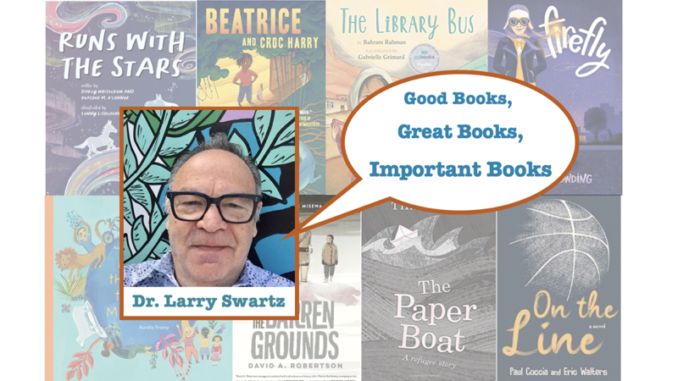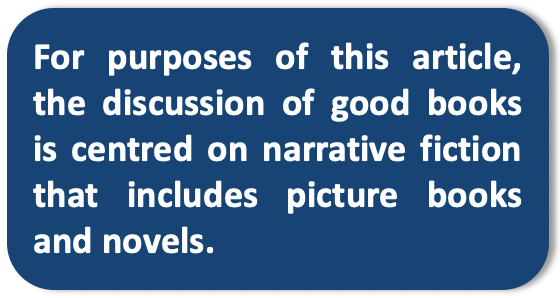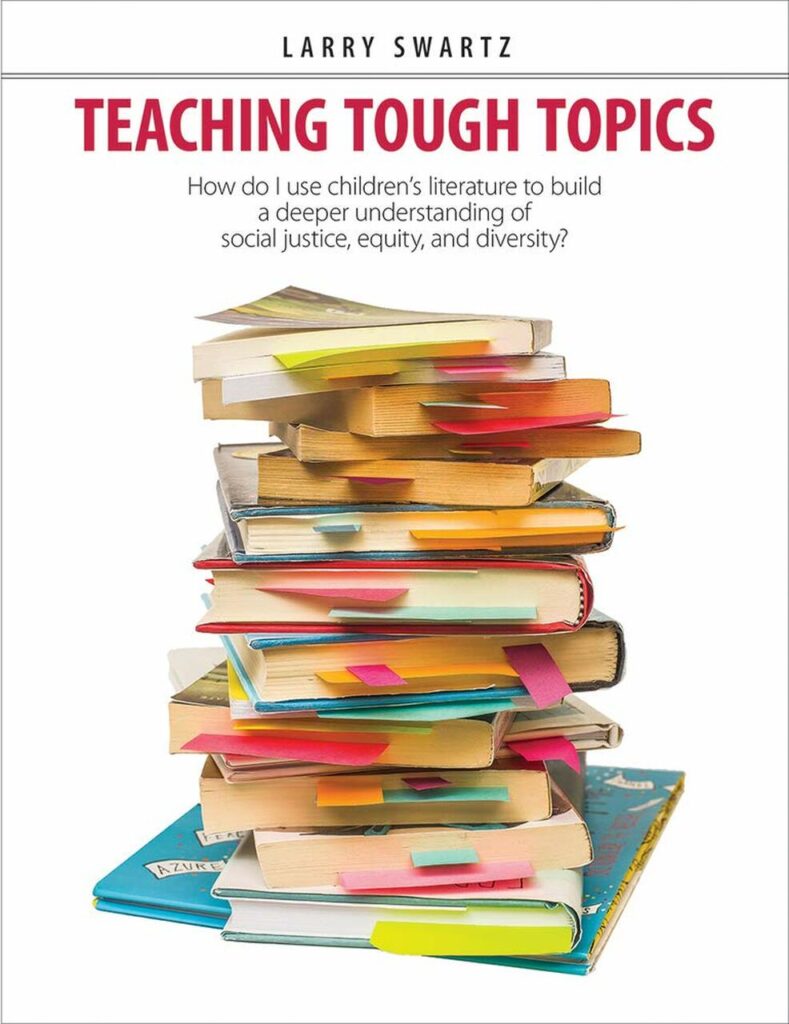
Considering Multicultural Literature That Engages Readers with Tough Topics
by Larry Swartz
Read Any Good Books Lately?
How often have you been asked by students, relatives, friends, or fellow librarians, “Read anything good lately?” When colleagues or young people ask us, “Have you got any good books?” how can we give the best answer, knowing that what is good for one may not appeal to another? It also begs the question, “What is good?” Is it good because the author is famous or because the book is on a bestseller list or won an award? Is it good because the book is short? beautifully illustrated? tickles the funny bone? touches the heart? entertains or informs? Perhaps a reader considers a book to be good because it was a special gift from someone, has interesting characters, an intriguing setting, presented (and resolved) a challenging problem. A good book can become a great book because it reminds us of our own lives. A good book can become a great book because it helps us learn about the lives of others. Great books are the best way to help students become independent, purposeful readers who will think carefully about what they have read and develop a lifelong love of reading.

For Shelley Stagg Peterson (2017) the word great denotes “a book that will have significant impact on a reader, that will stay with the reader long after it has been returned to the shelf.” (p. 8). Jon-Erik Lappano (2020), Governor General award-winning picture book author, claims, “Great books will find a way in. They play with hopes, fears, desires and joys we carry with us.” For author John Green, “Great books help you understand, and they help you feel understood.” The ability to say “This is a great book!” depends on the reader, the context, the culture.
I have enjoyed a career as a classroom teacher, consultant, workshop presenter, drama teacher, university instructor and author of a number of professional books for educators that have always been centred on choosing and using great books. Since the start of my teaching career—where I am challenged to offer the best books not only to build better readers, but also to find books that support expectations in a range of curriculum areas—I find myself on a mission to seek out titles of great books suggested from websites, journals, booksellers, friends and colleagues, librarian friends and from my students. I have always enjoyed sharing my choices with others in the classroom, in my university courses, through workshops and through my writing for educators. Isn’t it a wonderful thing when someone is curious enough and trusting enough to turn to us to ask for suggestions for good books? This, after all, helps to make a community of readers and it is through community that we can advise, share and recommend great books that we have enjoyed, and hope others will too.
The Importance of Multicultural Literature
Just as students are identifying with books they might call ‘great’, they should also be becoming aware of new perspectives and understandings through picture books and novels they encounter. Multicultural books allow students to see themselves as global citizens—to better understand their own beliefs, relationships and values and consider how to act on them. If readers can understand that books about tough topics can inform and educate, and that an author had a reason for writing the book, they can better consider what makes a book great for them. It helps to make great books into important ones to read.
A book can be considered to be great and important because it connects to our lives, cultural identities, and experiences—a mirror—or helps us learn about the lives of others—a window. The metaphors of windows and mirrors have a strong relationship with multicultural children’s literature and demand that we reconsider what to read, that is, who is represented, under-represented, and invisible in the curriculum and on bookshelves. I have always been aware of the need to promote multicultural literature; now more than ever I think it is vital that we promote books that help students to think about their place in the world and learn about belonging and tolerance as they read about the lives of others.
“When the reader stands in his own worldview, unable to see or conceive of any other perspective, a book can be a bridge. The right book, at the right time, can span the divide between where the reader stands in this moment and alternate views, new ideas, and options are considered.”
Lester L. Laminack and Katie Kelly (2019, xiii)
When young people experience a fictional narrative about settings or characters or problems that are not part of their world, they are invited to observe imaginary events that might or might not be ones that occur in real life. At the same time, they become participants in these events as they are drawn into the story and share the feelings and experiences of the characters. Picture books and novels therefore provide young people with the opportunity to reflect on human behaviours, emotions, values, relationships and conflicts. Readers can discover joy and satisfaction when they listen to a book read aloud, or when they are introduced to a selection of books that give them autonomy to choose titles for independent leisure reading.
Teaching Tough Topics by Larry Swartz (2020) is a comprehensive guide to choosing and using the best children’s literature to address sensitive but significant topics in the classroom. The ten tough topics explored are Race and Diverse Cultures; The Immigrant and Refugee Experience, Indigenous Identities; The Holocaust; Physical and Mental Challenges; Poverty; Death, Loss and Remembrance; Gender Identity and Homophobia; Bullying and Kindness.

Children’s literature helps us
- To make CONNECTIONS, inviting students to reveal their stories;
- To raise QUESTIONS about topics of concern, leading to INQUIRY;
- To learn about the IDENTITY and CULTURE of others…and reflect on our own identities;
- To explore narratives that serve as CASE STUDIES for relationships, values and struggles;
- To serve as ARTIFACTS for meaningful response (i.e., reading, writing, talk, media, the arts).
Books, especially books described as multicultural, can be the means to address tough topics that arise in the classroom, the community, the world and in students’ lives. Some children’s literature not only offers an alternative way of looking at the world but gives voice to people whose perspectives are rarely heard, or if heard are not valued. An expansion in the publishing of multicultural children’s literature has meant that there are now more titles reflecting how groups of people have felt oppressed or discriminated against. Children’s literature increasingly presents worlds whereby students are exposed to how people outside their experience live and struggle.
Multicultural literature now focuses on matters of race and ethnicity, and addresses such topics as sexual orientation, religion, poverty and immigration. It also celebrates individuals who act to improve our lives and build a better world for all. There are so many books that we can offer young people who want a good new book, and librarians and teachers have also been excited to find the right book for the right reader. To inform and learn about today’s life challenges, it is vital that we provide books that they need to read in order to deepen understanding of social justice goals. When these books help to promote diversity and equity goals such as belonging, acceptance, and equity; foster a sense of inclusion and confront intolerance, we are offering books that are good, that matter, for today’s students who are working for a better world tomorrow. This is important!
Maria José Botelho (2009), co-author of Critical Multicultural Analysis of Children’s Literature: Mirrors, Windows, and Doors addresses four caveats about the use of multicultural literature:
- One book cannot represent a cultural experience because there is diversity within and amongst cultural groups.
- Race and ethnicity should be at the centre of multicultural literature discussion. Whenever relevant, these power relations should be considered alongside class, gender, language and sexuality.
- Multicultural books are not immune to stereotypes and dominant world views. Children’s books are cultural products, records of the worldviews and publishing practices of the time in which they were produced.
- Though multicultural literature brings readers up close to the experiences of cultural groups, these experiences are often represented as just personal and cultural. These multicultural texts should be analyzed alongside and beyond other texts.
Unlike previous generations, today’s students can see their perspectives and cultures within the wealth of multicultural literature published in recent years. A special shout out goes to Canadian book publishers, who recognize that it is important to shine a light on diverse books that can help to make a difference in the diverse lives of readers. A small survey of books published in the last two years provides evidence of the need for these multicultural titles that illuminate tough topics. Characters from around the world appear in books such as The Library Bus and A Sky-Blue Bench by Bharam Rahman (Afghani girls), the free-verse story Burying the Moon by Andrée Poulin (India) and Deborah Ellis’s short story collection with multiple characters, each 11 years-old, each with different backgrounds. To help understand those who live in poverty, Jillian Tamaki’s award-winning Our Little Kitchen tells a story of kindness and community. Historical fiction by renowned author Kathy Kacer (Under the Iron Bridge; The Brushmaker’s Daughter) helps readers understand the history of the Holocaust. Further understandings of the impact of Antisemitism can be found in The Good Fight by Ted Staunton, No Vacancy by Tziporah Cohen. The story of swastikas damaging a small-town school in Gordon Korman’s Linked seems to be right off the news pages of recent Antisemitic hate crimes. To learn about the challenges of coming out, Paul Coccia and Eric Walters have teamed to tell the story of a father who announces to his son that he is gay in the book On the Line. To learn about the diversity of Indigenous Identities, there are many picture book titles (On the Trapline by David A. Robertson; We All Play by Julie Flett) and fiction titles by Indigeneous authors Michael Hutchinson (The Mighty Muskrat Mysteries); David A. Robertson (The Misewa Saga series) and Thomas King (Borders) to engage and inform readers. How can we make sense of the staggering refugee experience that fill news reports? Books such as the autobiographical My Name is Konisola by Alisa Siegel, The Paper Boat by Thao Lam and The Doll by Nhung N. Tran-Davies tell specific stories that serve as case studies for refugee survival.
Final Thoughts: Doors and Keys
“Stories matter. Many stories matter.”
Chimamanda Adichie, 2009
In an article entitled ‘The Need to Learn the Truth’, Joanne Robertson, author and illustrator of The Water Walker, reminds teachers that “if you are an educator choosing to explore FNMI learning in your classroom, know that we are diverse.” Yes, it is important to introduce young readers to a book that opens a window into a life that they may not know much about. But even more important is the invitation to offer several titles that open different perspectives, different stories; that show the diversity of lives lived. In this way, Multicultural Literature can open doors and move away from what Nigerian author and storyteller Chimamanda Adichie argues about in her Ted Talk, ‘The Danger of a Single Story’.
“The consequence of the single story is this: It robs people of dignity. It makes our recognition of our equal humanity difficult. It emphasizes how we are different rather than how we are similar.”
Children’s literature invites us to take readers to the whole world and to bring the whole world to the reader. We live in challenging times, and as librarians and teachers and parents we are called upon to help readers to learn about and respect the differences of others. If our goal is to open doors—to create caring citizens of the world, to build empathy and to deepen understanding of diversity, social justice and equity—then one of the keys to that learning is to offer literature that helps readers to reflect on their own identities and the identities of others. Activist and author Deborah Ellis (2018), when speaking at the 36th International IBBY conference, claimed, “Good children’s literature is not the sole key to a sustained livable future for all, but it is certainly one of the keys.”
Teaching Tips:
The following questions can help you reflect when choosing multicultural books.
- AM I IN THE BOOK? Do we offer books where characters look, talk and behave like the readers? Do all our readers see themselves reflected in the books we include in the classroom, school or community library?
- BOOKS AS MIRRORS How do the friendships and families compare to readers’ own friendships and families? Can readers identify with and connect to the struggles and accomplishments of characters in the books they read?
- BOOKS AS WINDOWS Do the available books help students gain an understanding of cultures, abilities, gender identities, class structures or life circumstances that may or may not be different to their own?
- OVERCOMING CHALLENGES Will readers meet characters who face similar or different challenges than the ones they have experienced, and can their stories help readers learn how to overcome those challenges if they should arise?
- RESPONDING TO TEXT Are opportunities provided for readers to respond critically to texts that celebrate differences and diversity, and that challenge the status quo?
- SHARING OUR ENTHUSIASMS When we are excited about a book we’ve experienced, sharing this enthusiasm is one of the best ways to motivate others.
References
Adichie, Chimamanda Ngozi (2009). “The Danger of a Single Story” https://www.youtube.com/watch?v=D9Ihs241zeg
Botelho, Maria José, and Masha Kabakow Rudman (2009). Critical Multicultural Analysis of Children’s Literature: Mirrors, Windows, Doors. New York: Routledge.
Ellis, Deborah (2019). “Creating a Day Before.” (IBBY) Bookbird 57 (1): 1-13.
Laminack, Lester. L. and Katie Kelly (2019). Reading to Make a Difference: Using Literature to Help Students Speak Freely, Think Deeply and Take Action. Portsmouth, NH: Heinemann.
Lappano, Jon-Erik (2020). “Great books will find a way in”. Open Book Interview, September 10 2020.
Peterson, Shelley Stagg, and Larry Swartz (2008). “This is a Great Book!”. Markham, ON: Pembroke.
Robertson, Joanne (2020). “The Need to Learn the Truth” In Teaching Tough Topics by Larry Swartz. Markham, ON: Pembroke.
Swartz, Larry (2020). Teaching Tough Topics: How do I use children’s literature to build a deeper understanding of social justice, equity and diversity. Markham, ON: Pembroke.
Children’s Literature
The following titles are recent publications (2021-2022) from Canadian authors. A suggested key theme is identified for each selection listed below.
Picture Books
Flett, Julie. We All Play.
O’Leary, Sara; illus. Qin Leng. A Kid is a Kid is a Kid (Also: A Family is a Family is a Family) (diversity, community)
Rahman, Bahram; illus. Gabrielle Grimard. The Library Bus (diverse cultures)
Rahman, Bahram; illus. Peggy Collins. A Sky-Blue Bench (physical challenges, kindness)
Robertson, David A.; illus. Julie Flett. On the Trapline (Indigenous identity, family)
Serres, Alain; illus. Aurélia Fronty. I Have the Right to Save My Planet. (Also: I Have the Right to Be A Child) (activism)
Tamaki, Jillian. Our Little Kitchen (poverty, kindness)
Tran-Davies, Nhung N.; illus. Ravy Puth. The Doll (the refugee experience, kindness)
Whitecrow, Darcy and Heather M. O’Connor; illus. Lenny Lishchenko. Runs with the Stars (Indigenous identity)
Fiction (ages 9 -12)
Coccia, Paul and Eric Walters. On the Line (homophobia, family)
Cohen, Tziporah. No Vacancy (religious differences; Antisemtism)
Dowding, Philippa. Firefly (mental health)
Ellis, Deborah. Step (short stories) (Also: Sit) (diverse cultures)
Hill, Lawrence. Beatrice and Croc Harry (Anti-Black Racism)
Hutchinson, Michael. The Case of the Burgled Bundle (Series: Mighty Muskrat Mysteries) (Indigenous Identity)
Kacer, Kathy. Under the Iron Bridge (also: The Brushmaker’s Daughter) (The Holocaust; Antisemitism)
King, Thomas. Borders (Anti-Indigenous racism)
Korman, Gordon. Linked (Antisemitism)
Lam, Thao. The Paper Boat: A refugee story (the refugee experience)
Nanji, Shenaaz. Alina in a Pinch (diverse cultures, bullying)
Poulin, Andrée; illus. Sonali Zohra. Burying the Moon (poverty)
Robertson, David A. The Barren Grounds (Book One of ‘The Misewa Saga’) (Also: The Great Bear: Book 2; The Stone Child: Book 3) (Indigenous Identity)
Siegel, Alisa. My Name is Konisola (the refugee experience)
Staunton, Ted; illus. Josh Rosen. The Good Fight. (Antisemitism)

Larry Swartz is currently an instructor at OISE/UT where he teaches courses in literacy, children’s literature and inclusive education. For the past four decades, he has been a classroom teacher, consultant and workshop and keynote presenter, committed to helping educators use quality children’s literature across the curriculum to inspire students to read, read, read. He is the author of several professional resources including, Better Reading Now, Take Me to Your Readers, and Teaching Tough Topics. Larry’s website Dr Larry Recommends offers monthly suggestions of picture books, fiction, nonfiction and grown-up reads.